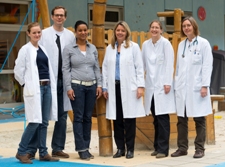German Collaborative Asthma Cohort

Bronchial asthma is one of the most common chronic lung diseases in childhood and adolescence.
In the majority of patients suffering from asthma, the first symptoms appear in early childhood. However, only a minority of patients who experience wheezing typical of asthma within the first 2-3 years of their lives develop allergic asthma at school age. The most common school-aged asthma phenotype is associated with atopic sensitization to seasonal and perennial allergens, yet other children also suffer from non-allergic asthma for years.
During adolescence, the symptoms improve in some asthmatic patients, but for a significant proportion of patients symptoms return in adulthood. In another group of patients, the symptoms do not diminish even in adolescence, but continue to develop into asthma in adulthood and associated pathological changes in the airways. These patients are at high risk of developing a severe form or difficult-to-treat form of asthma. Although only about 5 to 10% of asthma patients suffer from this severe condition, the cost of their treatment represents a disproportionate share of the health costs of the disease.
In order to predict how a disease will progress and how it should be treated, the DZL launched the All Age Asthma Cohort (ALLLIANCE Cohort) in the first funding period. It now includes more than 1,000 patients and healthy volunteers between the ages of six months and 84 years-of-age. After a comprehensive baseline investigation, the asthma patients usually come to the respective study centers annually. Healthy volunteers who serve as a control group are examined once.
As part of the study program, the ALLIANCE study team measures the lung function and airway inflammation of the test persons and examines the extent to which they are sensitized to certain allergens. Biomaterials such as blood, nasal swabs, sputum and exhaled air are collected and analyzed. Structured interviews, questionnaires and data from the patient records document symptoms, disease progression, living conditions and environmental factors. In order to be able to directly compare the results in children and adults, the spectrum of examinations is as similar as possible and the processes are standardized.
With the help of a whole series of in depth molecular-biological analysis methods ('deep phenotyping') mechanisms of the different courses of the disease are to be elucidated. The data and biobanks of the ALLIANCE cohort now include hundreds of thousands of data points and patient samples. Their analysis has already begun. The aim of the study is to identify biomarkers (signaling molecules), which should make it possible to identify the respective sub-form of the disease as early as possible in the future. This would also make it possible to tailor the treatment to each individual patient much more individually.
Scientific Head:
Prof. Dr. Gesine Hansen
Cooperating Partners within the DZL: Airway Research Center North (ARCN),
Biomedical Research in Endstage And ObsTructive Lung Disease Hannover (BREATH), Comprehensive Pneumology Center (CPC) Munich, Universities of Giessen and Marburg Lung Center (UGMLC)